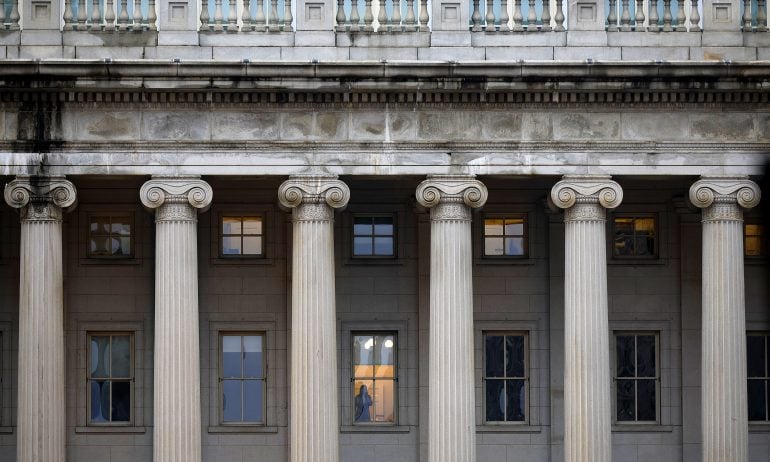When Will the Government Run Out of Money?

Many or all of the products featured here are from our partners who compensate us. This influences which products we write about and where and how the product appears on a page. However, this does not influence our evaluations. Our opinions are our own. Here is a list of our partners and here's how we make money.
The federal government has mere weeks before it runs the risk of defaulting on its debt, the Treasury Department reported to the Biden administration Monday. The so-called X-date is expected as early as June 1.
Treasury Secretary Janet Yellen said in a letter to Congress that it was impossible to predict an exact date, but based on current data, the Treasury expects it would be unable to continue to repay the government’s debts by early June. In the letter, she wrote, “Given the current projections, it is imperative that Congress act as soon as possible to increase or suspend the debt limit in a way that provides longer-term certainty that the government will continue to make its payments.”
It’s sooner than many analysts expected, which means Congress has little time to come to an agreement and raise the debt ceiling. But political polarization is stymieing a consensus. House Republicans are gunning to negotiate — they’ll play ball on the debt ceiling, but only if Democrats agree to a long list of cutbacks. Democrats, led by the White House, are pushing back.
All the while, the federal government is inching closer to missing its payments, which could trigger a financial crisis with worldwide implications.
How we got here
The United States hit its $31.381 trillion debt ceiling, or limit, on Jan. 19. Once that debt limit is reached, the federal government is at risk of default.
The Treasury Department began to implement “extraordinary measures” shortly thereafter so the government could continue to meet its legal obligations — already approved by Congress — to fund things like Social Security, Medicare, tax refunds and military salaries. Those extraordinary measures include suspending payments on retirement and health care funds for government employees.
In the Treasury’s letter to Congress on Monday, the department said it was also suspending the issuance of State and Local Government Series Treasury securities, which are issued to states and municipalities to help them comply with certain tax rules. These securities count against the debt limit.
Those measures are expected to fund the government until June, Yellen wrote in a letter Jan. 13 and reiterated in her letter to Congress on Monday. By mid-June, the Treasury is expected to receive a cash infusion from non-withheld tax payments that could keep it running into late July, according to Moody’s Analytics, a financial services company that evaluates economic risk.
Congress is in charge of raising the debt limit, and it’s a routine occurrence; it has been modified 20 times since 2002. What’s atypical is negotiation, which is where the process is embroiled now. Republicans in Congress are demanding cuts in exchange for raising the debt ceiling.
William Gale, senior fellow in the economic studies program at the Brookings Institution, a nonprofit research organization focused on public policy, says negotiating the debt ceiling creates an “artificial emergency” with real implications to the financial system.
Gale points out that House Republicans’ argument for cuts to raise the debt ceiling doesn’t make much sense because the government can only spend what Congress has authorized it to spend. All raising the debt ceiling does is ensure the U.S. can make payments on money it has already borrowed to fund programs and services.
“Congress can tell the government, ‘You need to spend $100, but we're not going to provide you the means of financing that $100,’ and so, then they raise the debt limit, and that provides them the means of financing that spending,” Gale says. “But it's an archaic, dysfunctional system that doesn't have anything to do with new spending.”
House Republicans bargain for cuts
House Republicans passed Speaker Kevin McCarthy’s Limit, Save, Grow Act on April 26. It would raise the debt limit by $1.5 trillion or through the end of March 2024, depending on which comes first. In exchange, the government would cut spending by $4.5 trillion in the next decade.
The bill would also increase fossil fuel production, add work requirements to government assistance programs, claw back pandemic funding, eliminate IRS improvement funding and kill President Joe Biden's proposed student loan forgiveness plan.
An April analysis from Moody’s Analytics found that the act would cut near-term economic growth and would “meaningfully increase the likelihood” of a recession.
Democrats in Congress have dubbed the bill the “Default on America Act,” with several senators calling it dead on arrival. That means negotiations are likely playing out behind closed doors.
Karine Jean-Pierre, the White House press secretary, said in a prepared statement April 26: “The president has made clear this bill has no chance of becoming law.” She said congressional Republicans must act immediately “and without conditions” to increase the debt ceiling. “That is their job,” she added.
What happens if the U.S. defaults?
Default would be very bad at best and catastrophic at worst. The U.S. has defaulted only once, and it was due to a technical glitch in 1979. But it has also come close before under similarly contentious circumstances in Congress. In 2011, negotiations dragged on so long the S&P downgraded the U.S. credit rating, which contributed to volatility in the markets.
A default that lasts longer than a few days could result in a financial crisis that reverberates around the world. It could include a sell-off of U.S. debt; money market funds selling out; suspension of federal benefits; increased interest rates on lending products and mortgages; tanking stock markets; delayed tax refunds; and the gross domestic product, or GDP, plummeting. In case all of that didn’t make this obvious, a default would also accelerate the arrival of a recession.
“I think it's important for people to realize that we're talking about financial markets, but this can have a real effect on people,” Gale says.
Those real-world effects would, at minimum, include higher interest rates and tightened credit requirements, Gale says, at a time when the Federal Reserve has already increased interest rates nine times since March 2020 and is largely expected to increase them again this week.
The U.S. economy runs on short-term credit, Gale says, and if the flow of credit stops, there could be real consequences for Americans. “It’s like putting a pointed stick in the bicycle spokes,” he says.
How do you solve a problem like the debt ceiling?
The clearest route to avoiding default is if Congress agrees to raise the debt ceiling quickly before we hit the X-date. But other options have been raised.
It’s unclear whether Biden would attempt to use executive power to lift the debt ceiling without congressional approval. It also raises the question of the legality of such an action.
There are a few other ideas that have been floated that range from “sober finance” to “tin-hat silliness,” Gale says. Those ideas include:
• Minting the trillion dollar coin. A once-fringe, now-mainstream strategy to bypass the debt limit by having the Treasury mint a trillion-dollar platinum coin and deposit it into the Federal Reserve. Gale says he has no idea whether the Fed would accept this option or the legality of it.
• The Treasury issues consol bonds to meet debt obligations. These bonds, also called perpetuity bonds, pay out interest and have no maturity date. The lack of a maturity date means these bonds wouldn’t count under the debt ceiling.
“The Treasury can say, 'Here's a piece of paper. If you give us a dollar, we'll give you whatever the Treasury interest rate is, forever.' So every year you get a payment,” Gale says. “But the thing never pays off. It’s not a 10-year Treasury or a 30-year Treasury. It's infinite, so it wouldn't count under the debt ceiling.”
• The Fed returns Treasury debt back to the Treasury. The majority of federal debt is made up of Treasury securities. At its peak in early 2022, the Fed held $6.25 trillion in federal debt. By the close of the year, it was around $5.9 trillion.
There are other potentially serious, potentially gimmicky options in addition to the ones above, but the most feasible option is always the simplest: Congress acts, and Biden signs.
Photo by Chip Somodevilla/Getty Images via Getty Images

